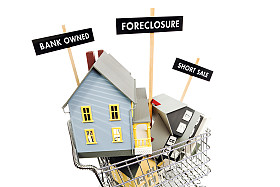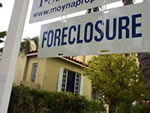Foreclosures
Foreclosure News Items
Foreclosure crisis isn't half over
by Broderick Perkins
(11/30/2011) - "Foreclosures continue to hammer the housing market and subprime mortgages keep wrenching homeownership from millions."
That's the same lead published in 2009.

Like it or not, it's still the same old story, according to a mash-up of recent troubling housing market reports.
Five years since the housing market crashed, and some 2.7 million foreclosures later, the housing market is bracing for yet another 3.6 million foreclosures in the years to come, according to a new report from the Center For Responsible Lending (CRL).
"That means the nation is not yet midway through a foreclosure crisis that mires the economy. We warned early-on about the abusive lending practices wrecking the economy," according to "Lost Ground, 2011: Disparities in Mortgage Lending and Foreclosures."
CRL isn't alone in forecasting a bleak and prolonged down turn for the housing market, still heavily weighed down by too many toxic mortgages.
• "The housing market is almost as bad as it has ever been absent the Great Recession,'' said Nicolas Retsinas, a senior real estate lecturer and Director Emeritus at Harvard University's Joint Center for Housing Studies.
"We have a situation where the tried and true methods don't hold water," he added.
Harvard's bleary "State of the Nation's Housing 2011" includes a litany of obstacles in the way of a housing recovery, from chilled consumer confidence, foreclosures and lackluster home sales to unemployment, underwater homeowners and underwriting standards that are tighter than ever.
• This week, John Burns Real Estate Consulting reported the rate of homeownership is likely to fall eight percentage points, from the peak of near 70 percent in 2005 to 62 percent in 2015, before it's all over.
But Burns Consulting says it won't be until 2025 before the homeownership rate returns to 67.1 percent, still well off the peak. The report blames continued foreclosures, short sales, poor consumer confidence and an anemic economy for the housing slump.
Other reports push the crisis out only until 2020.
• Earlier this month Standard & Poors said at the current rate of sales, clearing the market of distressed homes is still nearly four years away -- three months longer than S&P estimated a year ago.
"Though fewer additional loans are currently defaulting, the overall volume of distressed loans remains huge. Low liquidation rates over the past two years allowed the shadow inventory to grow as distressed homes have remained tied up in foreclosure proceedings," writes Diane Westerback, managing director of Structured Finance for S&P's Rating Services.
The CRL's exhaustive report lays much of the blame for the continued housing crash on patterns of risky lending. It says foreclosure rates are consistently worse for borrowers who received toxic loans that were heavily marketed before the housing crash.
The report covers foreclosures from 2004 and 2008 and says matters could become worse than the report suggests.
Findings include:
• Among mortgages made between 2004 and 2008, 6.4 percent have ended in foreclosure, and an additional 8.3 percent are at immediate, serious risk.
"It is notable that these serious delinquencies represent only a sub-set of likely foreclosures ahead, since they do not include foreclosures on loans originated outside our origination time frame or those that are not yet at imminent risk."
• Loan characteristics and foreclosures are strongly linked. Loans originated by brokers, hybrid adjustable-rate mortgages (ARMs, such as 2/28s), option ARMs, loans with prepayment penalties, and loans with high interest rates (a proxy for subprime mortgages) all have much higher rates of completed foreclosures and are more likely to be seriously delinquent.
• Most affected borrowers are white, but African-American and Latino borrowers are nearly twice as likely to have been impacted by the crisis. Nearly one quarter of all Latino and African-American borrowers have lost their home to foreclosure or are seriously delinquent, compared to just under 12 percent for white borrowers.
If that isn't enough doom and gloom, the report also includes a "Foreclosure Damage Index" a by-the-numbers nightmare for housing and a interactive map to track foreclosures and serious delinquencies by region, race, and income.
Fannie Mae & Jumbo Mortgage Rates
Just One Click! = Current Rate Chart

Start by selecting your state
Other related articles:
Foreclosure reviews available for 4.5 million consumers
Federal foreclosure assistance program falls short of goals
Extended EHLP (Read 'Help')deadline for homeowners facing foreclosure, employment struggles
Government considering new foreclosure plan
Are fewer foreclosure numbers due to book cooking?
Refinance at Today's Low Rates!

